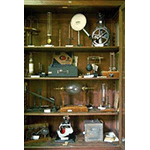Polo Tecnico Statale di Firenze [Florence State Technical Centre]
Today's Polo Tecnico was formed in 1999 by uniting two schools: the Istituto Tecnico per Geometri "Gaetano Salvemini" ["G. Salvemini" Technical Institute for Surveyors] and the Istituto Tecnico Commerciale "Duca D'Aosta" ["Duca D'Aosta" Technical Institute for Commercial Studies].
The former derives from the Istituto Tecnico Toscano, founded in 1853 by Grand Duke Leopold II of Lorraine. The school, which drew from the practical-experimental tradition of Tuscan science, had the scope of training qualified technicians in the spheres of agriculture, craftsmanship and the nascent fields of industry. The Institute, which collaborated with Tuscany for its exhibits at the Universal Expositions of London and Paris, benefited by the dedicated work of its first director, Filippo Corridi, who set up important scientific and technological collections as well as a fine library on its premises. The director of the Institute also supervised the Tuscan Academy of Arts and Crafts, instituted to promote closer collaboration among industrialists, craftsmen and scientists, with the aim of relating the theoretical concepts of science to the practical processes of industry.
The courses taught at the Institute, inaugurated in 1857, were divided into three sections: physical-mechanical technology, physical-chemical technology and land-surveying. In 1863 the sections were rearranged, becoming four in number: Agronomy and Land-surveying; Commerce and Administration; Mechanics and Construction; Mining and the Metallurgical Industry. In the 1970s, the commercial sector was detached and the old institute was renamed the Istituto Tecnico per Geometri "Gaetano Salvemini".
Some of Salvemini's collections are still kept at the school, on the old premises in Via Giusti; others have been granted to the Fondazione Scienza e Tecnica [Science and Technology Foundation]. The "G. Salvemini" collection consists of two main groups. The scientific collection includes chemical apparatus (glassware, laboratory instruments, measurement instruments, minerals and chemical substances) and educational instruments for physics. The technical collection consists of a "Little Agricultural Museum" (models of farm machines and tools used for processing agricultural products, instruments for analysis, research and measurement, naturalist specimens and a collection of product types), a "Little Topographical Museum" (instruments for surveying, measuring and drawing) and a Constructions collection (models of vaults, trussed beams, pilasters, bridges and samples of materials). The 1,470 specimens date mainly from the 19th and 20th centuries.
The Istituto Tecnico Commerciale "Duca d'Aosta" was founded in 1876, on the premises of a former monastery. It too, from the very beginning, possessed educational instruments for physics and naturalist specimens, which are still today to be found on the original premises in Via della Colonna. The "Duca d'Aosta" collection consists of three groups containing around 326 specimens: a physics collection with educational instruments, accounting machines from the late 19th century and measurement instruments (scales and density meters), a collection of minerals and rocks and one of models, in wood and plastic, of bones and plants.
****************************
Texts by Graziano Magrini
English translation by Catherine Frost
Last update 12/feb/2008




